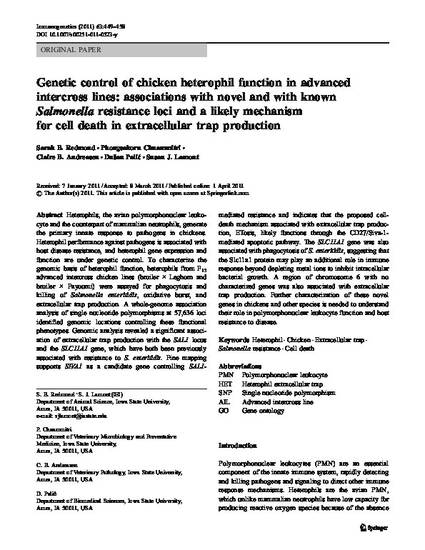
Heterophils, the avian polymorphonuclear leukocyte and the counterpart of mammalian neutrophils, generate the primary innate response to pathogens in chickens. Heterophil performance against pathogens is associated with host disease resistance, and heterophil gene expression and function are under genetic control. To characterize the genomic basis of heterophil function, heterophils from F13 advanced intercross chicken lines (broiler × Leghorn and broiler × Fayoumi) were assayed for phagocytosis and killing of Salmonella enteritidis, oxidative burst, and extracellular trap production. A whole-genome association analysis of single nucleotide polymorphisms at 57,636 loci identified genomic locations controlling these functional phenotypes. Genomic analysis revealed a significant association of extracellular trap production with the SAL1 locus and the SLC11A1 gene, which have both been previously associated with resistance to S. enteritidis. Fine mapping supports SIVA1 as a candidate gene controlling SAL1-mediated resistance and indicates that the proposed cell-death mechanism associated with extracellular trap production, ETosis, likely functions through the CD27/Siva-1-mediated apoptotic pathway. The SLC11A1 gene was also associated with phagocytosis of S. enteritidis, suggesting that the Slc11a1 protein may play an additional role in immune response beyond depleting metal ions to inhibit intracellular bacterial growth. A region of chromosome 6 with no characterized genes was also associated with extracellular trap production. Further characterization of these novel genes in chickens and other species is needed to understand their role in polymorphonuclear leukocyte function and host resistance to disease.
Available at: http://works.bepress.com/claire_andreasen/30/

This article is from Immunogenetics 63 (2011): 449, doi:10.1007/s00251-011-0523-y. Posted with permission.